Notes on Liber Resh
One of the main factors which contributed to human life is the Sun. If the Sun disappears, we cease to exist. The Sun allowed human life, and the Sun sustains human life. Perceiving that, the people from ancient times (who explained natural phenomena through myths) told us how the God Sun would set at Evening or fade in the Winter through myths associated with death and rebirth, and thus we have many solar deities and myths associated with resurrection.
As the centuries went by, two things changed:
- We know that the Sun never “goes away” and “returns”, it is always there shining. It is through Earth’s rotation and inclination that we perceive day and night, summer and winter.
- The spiritual Sun is not out there anymore. God is not a being sitting on a cloud and judging our choices. We are divine, God is within us.
Then why the heck would I “adore” the Sun through practices such as Liber Resh?
What is Liber Resh vel Helios #
Liber is Latin for “book”, and Resh is a Hebrew letter associated with the Astrological Sun and The Sun Tarot Card. Helios is a Greek Sun God. Thus the entire symbolism points towards the Sun.
Liber Resh was written by Aleister Crowley and it was originally published in 1911 in The Equinox Vol. I Number 6, the official biannual publication of the A∴A∴. It was classified under Class D, i.e., the group of A∴A∴ publications which “[…] consists of the Official Rituals and Instructions”.
Basically, Liber Resh provides four adorations to the Sun which should be performed at sunrise, noon, sunset, and mid-night, directed to four Egyptian Solar deities: Ra, Ahathoor, Tum, and Kephra.
Crowley didn’t create Resh out of the blue, these are a few possible inspirations:
- Sūrya Namaskār, a Hindu Solar adoration directed to the Sun God Sūrya through a smooth sequence of Āsanas (postures) extracted from Haṭha Yoga. It became popular in the 1920s. Crowley studied Yoga in Sri Lanka and India, so it is possible that he had contact with that practice.
- Salah, five daily adorations to Allah to be performed by Muslins. Basically, they follow the same pattern as Resh, however, there’s an additional adoration between noon and sunset, and the midnight adoration actually can be performed between 1 ½ after sunset and midnight. (This flexibility would allow a longer night of sleep for Resh practitioners!). Crowley also traveled extensively through Muslim lands, such as Egypt, Algeria, Turkey, etc.
- The Papyrus of Ani, one of the Egyptian Books of the Dead. There are many passages that resemble the structure of the four adoration found in Resh. For example: “Homage to thee, Osiris, Lord of eternity, King of the Gods, whose names are manifold, whose forms are holy, thou being of hidden form in the temples, whose Ka is holy. Thou art the governor of Tattu […]”, etc and etc.
Although Liber Resh was published in 1911, there are possible mentions of it as early as 1904, according to the research of Vinicius Mesquita. We read in the Book of Results (March 1904 — emphasis is ours):
"The ordeal of [Earth] = 3 days [unreadable] in silence + darkness. He bears only the ‘Hail!’ of the 4 periods.
The ordeal of [Fire]. Exposure on the desert without clothes, shade, food, or drink. He [unreadable] at dawn Ra, at noon Ahathoor, at sunset Tum, when he is fetched away."
Also, in Liber AL vel Legis (April 1904 — emphasis is ours):
"[…] There is a secret door that I shall make to establish thy way in all the quarters, (these are the adorations, as thou hast written) […]
I have made a secret door
Into the House of Ra and Tum,
Of Khephra and of Ahathoor […]"
So it’s possible that Crowley started working on Resh at some point between his visit to the Egyptian Museum in Cairo (where he and his wife Rose found the Stéle of Ankh-f-n-Khonsu cataloged under the number 666) and the Great Invocation.
The Purpose of Liber Resh #
We can summarize its aims as follows:
- Composing the mind for meditation;
- Regularize our practices;
- Contact the center of our system;
- Draw force from the Sun;
- Conquer the fear of death;
- Affirm one’s place in Nature.
Let’s read Crowley’s own words about this practice, beginning with the actual description of Liber Resh as found in the Syllabus of the Official Instructions of the A∴A∴, published in The Equinox Vol. I No. 10:
“An instruction for adorations of the Sun four times daily, with the object of composing the mind to meditation and of regularizing the practices.”
Crowley also described that book in his Confessions, page 673:
“The Book of the Sun. Here are given the four Adorations to the sun, to be said daily at dawn, noon, sunset and midnight. The object of this practice is firstly to remind the aspirant at regular intervals of the Great Work; secondly, to bring him into conscious personal relation with the centre of our system; and thirdly, for advanced students, to make actual magical contact with the spiritual energy of the sun and thus to draw actual force from him.”
Again, in Magick Without Tears, one of the last books he prepared (released after his death), he writes in Chapter 63:
“Particularly useful against the fear of death is the punctual and vigorous performance of Liber Resh. Meditate on the sun in each station: his continuous and even way: the endless circle.”
Crowley also mentions Resh in that same book’s Introduction:
“As I told you yesterday, the first essential is the dedication of all that one is and all that one has to the Great Work, without reservation of any sort. This must be kept constantly in mind; the way to do this is to practice Liber Resh vel Helios sub figura CC, pp. 425-426 - Magick. There is another version of these Adorations, slightly fuller; but those in the text are quite alright. The important thing is not to forget. I shall have to teach you the signs and gestures which go with the words.”
Finally, we will quote from the chapter De Cultu, in Liber Aleph (our emphasis):
"Now, o my Son, that thou mayst be well guarded against thy ghostly Enemies, do thou work constantly by the Means prescribed in our Holy Books.
Neglect never the fourfold Adorations of the Sun in his four Stations, for thereby thou doest affirm thy Place in Nature and her Harmonies.
Neglect not the Performance of the Ritual of the Pentagram, and of the Assumption of the Form of Hoor-pa-Kraat.
Neglect not the daily Miracle of the Mass, either by the Rite of the Gnostic Catholic Church, or that of the Phoenix. Neglect not the Performance of the Mass of the Holy Ghost, as Nature herself prompteth thee.
Travel also much in the Empyrean in the Body of Light, seeking ever Abodes more fiery and lucid.
Finally, exercise constantly the Eight Limbs of Yoga. And so shalt thou come to the End."
It seems Crowley put Liber Resh on a high pedestal among other essential practices. But why is Liber Resh so important? What is “the End” mentioned by Crowley?
Adorations and the Great Work #
We must start by understand what is that “End” mentioned by Crowley, and then how Liber Resh may help us towards It. As already mentioned, Resh is an official A∴A∴ publication, so let’s read what It has to say about the “End”.
From that same magazine where Resh was published, The Equinox, let’s quote from the essay Postcards to Probationers found in the second issue (our emphasis):
“The world progresses by virtue of the appearance of Christs (geniuses). Christs (geniuses) are men with super-consciousness of the highest order. Super-consciousness of the highest order is obtainable by known methods. […] The essential acts are retirement and concentration — as taught by Yoga and Ceremonial Magic.”
Okay, so the two pillars of A∴A∴ are Yoga and Ceremonial Magic (or Magick). These two are split into four main methods, as described by that same essay:
| Union by | Yoga | Magick |
|---|---|---|
| Knowledge | Jñāna Yoga | The Holy Qabalah |
| Will | Rāja Yoga | The Sacred Magic [of Abramelin the Mage] |
| Love | Bhakti Yoga | The Acts of Worship |
| Courage | Haṭha Yoga | The Ordeals |
Liber Resh looks like a good fit for a method of union through love, because it is a set of adorations and exercise our devotion. According to the Oxford Dictionary, adoration can be defined as:
- deep love and respect.
- worship; veneration.
Okay, but as Thelemites, as people who believe “There is no God but man”, “Deus est homo”, that the divine is within us, why the heck would I turn myself to the Sun and adore it?
The purpose of A∴A∴ is to “select Adepts”. Adepts are expected to attain the Great Work, which for them is the Knowledge and Conversation of the Holy Guardian Angel. There’s a set of “lesser works” through the initial stages of A∴A∴ which build up and are devoted to this sole final task. But what “adorations” have to do with K & C?
Let’s quote again from Liber Aleph, chapter De Gradibus ad Magnum Opus (our emphasis):
"This Great Work is the Attainment of the Knowledge and Conversation of thine Holy Guardian Angel. In the Eight Aethyr is the Way thereof revealed. But I say: prepare thyself most heartily and well for that Battle of Love by all means of Magick. […] In the Preparation thou shalt have learnt how thou mayst still all Thoughts, and reach Ekstacy of Trance in many Modes. […] Here, o my son, is the One Secret of Success in this Great Work: Invoke often.
So, the only secret to success in the Great Work (of the K & C of the H.G.A) is “invoke often”. What else Crowley has to say about this secret? Let’s quote from one of the official instructions assigned to the Adeptus Minor, Liber Samekh, whose aim is to attain to the Angel:
“Let the Adept perform this Ritual aright, perfect in every part thereof, once daily for one moon, then twice, at dawn and dusk, for two moons, next, thrice, noon added, for three moons, afterwards, midnight making up his course, for four moons four times every day. Then let the Eleventh Moon be consecrated wholly to this Work; let him be instant in continual ardour, dismissing all but his sheer needs to eat and sleep. For know that the true Formula whose virtue sufficed the Beast in this Attainment, was thus: INVOKE OFTEN.”
Again Crowley says the only secret, now called the true formula, is to “Invoke Often”. But there’s a new variable: “continual ardour”. What’s that? Well, fortunately, Crowley also gave us the secret to the secret (“invoke often”). Let’s quote from Magick in Theory and Practice, Chapter XV, Of the Invocation:
“But the secret of success in invocation has not hitherto been disclosed. It is an exceedingly simple one. It is practically of no importance whatever that the invocation should be “right”. There are a thousand different ways of compassing the end proposed, so far as external things are concerned. The whole secret may be summarised in these four words: ‘Enflame thyself in praying’.”
Okay! And how do I, in that most important moment, enflame myself out of nowhere without practice? How can I develop the required devotion for something intangible and which even those who attained to It couldn’t explain Its proper Nature? That’s where we adopt Liber Resh: the Sun is just a prop we will use to learn how to properly enflame ourselves in praying, to learn how to be in continual ardour, so that at the ultimate invocation of the Holy Guardian Angel we are prepared to devote our Hearts fully.
Performing Liber Resh #
Now let’s quote from Liber Resh vel Helios and discuss its instructions:
“0. These are the adorations to be performed by all aspirants to the A∴A∴.”
This does not mean that these instructions are only intended for aspirants to the A∴A∴, anybody can practice them, but if you are an aspirant, you must perform them.
Sunrise #
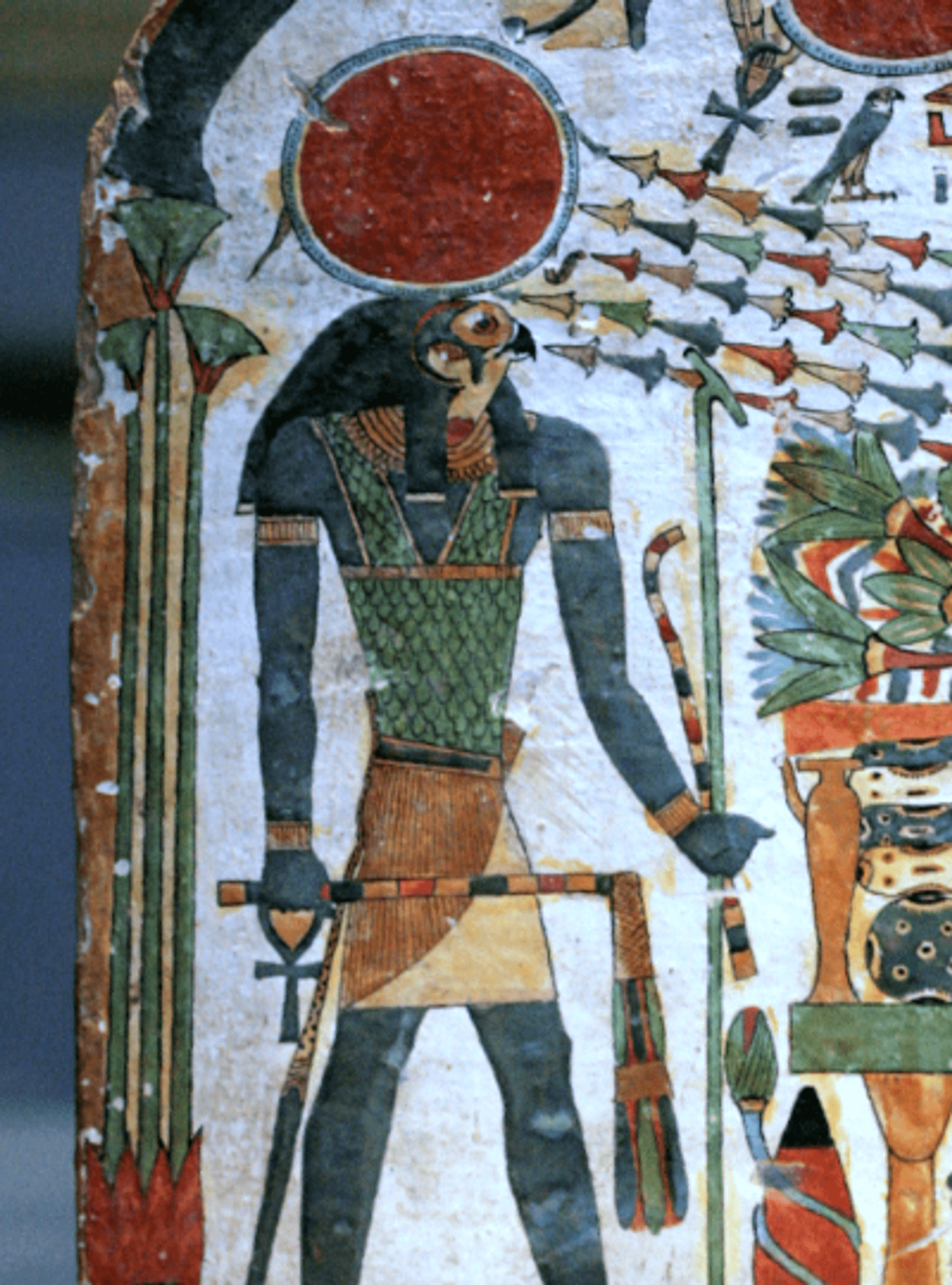
"1. Let him greet the Sun at dawn, facing East, giving the sign of his grade. And let him say in a loud voice:
Hail unto Thee who art Ra in Thy rising, even unto Thee who art Ra in Thy strength, who travellest over the Heavens in Thy bark at the Uprising of the Sun.
Tahuti standeth in His splendour at the prow, and Ra-Hoor abideth at the helm.
Hail unto Thee from the Abodes of Night!"
The practitioner faces East because that’s where the Sun is at Dawn.
Note that the adoration must be performed in a loud voice.
Now, if you are not a member of the A∴A∴, how can you give “the sign of [your] grade”? Different schools came up with different answers to this question. Some of them suggest that you give the elemental sign attributes to the quarter you are facing, for example:
- East is Air, Sign of a Zelator 2○=9□;
- South is Fire, Sign of a Philosophus 4○=7□;
- West is Water, Sign of a Practicus 3○=8□;
- North is Earth, Sign of a Neophyte 1○=10□.
Other schools suggest that you should give one of the signs attributed to the lowest Grade in the A∴A∴, that of the Probationer 0○=0□: the Sign of Silence or the Sign of the Enterer (this is preferred since the other sign is already given in another section of Liber Resh that will be spoken of bellow).
However, although it is not very well known, Crowley noted in his own personal copy of The Equinox Vol. I Number 6 the signs that should be given by someone who is not in the A∴A∴. Those commentaries were published as an appendix to the Samuel Weiser 2-books set of The Equinox Vol. I., on 1999. The note reads as follows:
“Where the aspirant has no grade, let him give the signs given [No. 1, ‘Liber O’, plate ‘The Signs of the Grades’ facing p. 12]; The L.V.X. signs at dawn, 4○=7□ at noon, 2○=9□ at sunset, 3○=8□ at midnight.”
The Signs of L.V.X. are attributed to the Grade of Adeptus Minor 5○=6□, thus the practitioner is surrounded by the sephiroth of Tiphareth, Netzach, Hod, and Yesod, as if one was standing at the intersection of the Paths of Samekh and Peh:

Okay, now we have a problem, because there are four signs attributed to the rising Sun: Osiris slain (the Cross), Isis mourning (L), Typhon (V), and Osiris risen (X). Should we give all of them, should we choose one?
It looks like it would be an over-emphasis to the Dawn if you make it different by giving so many signs. If we were to pick one of those four signs, which one would make more sense? Of those three Egyptian Gods, only one is attributed to Tiphareth in 777: Osiris. However, Osiris has two signs. Since L.V.X. is “the light of the cross”, and the Sign of the Cross represents all the other signs, it may be a good option for East / Tiphareth:
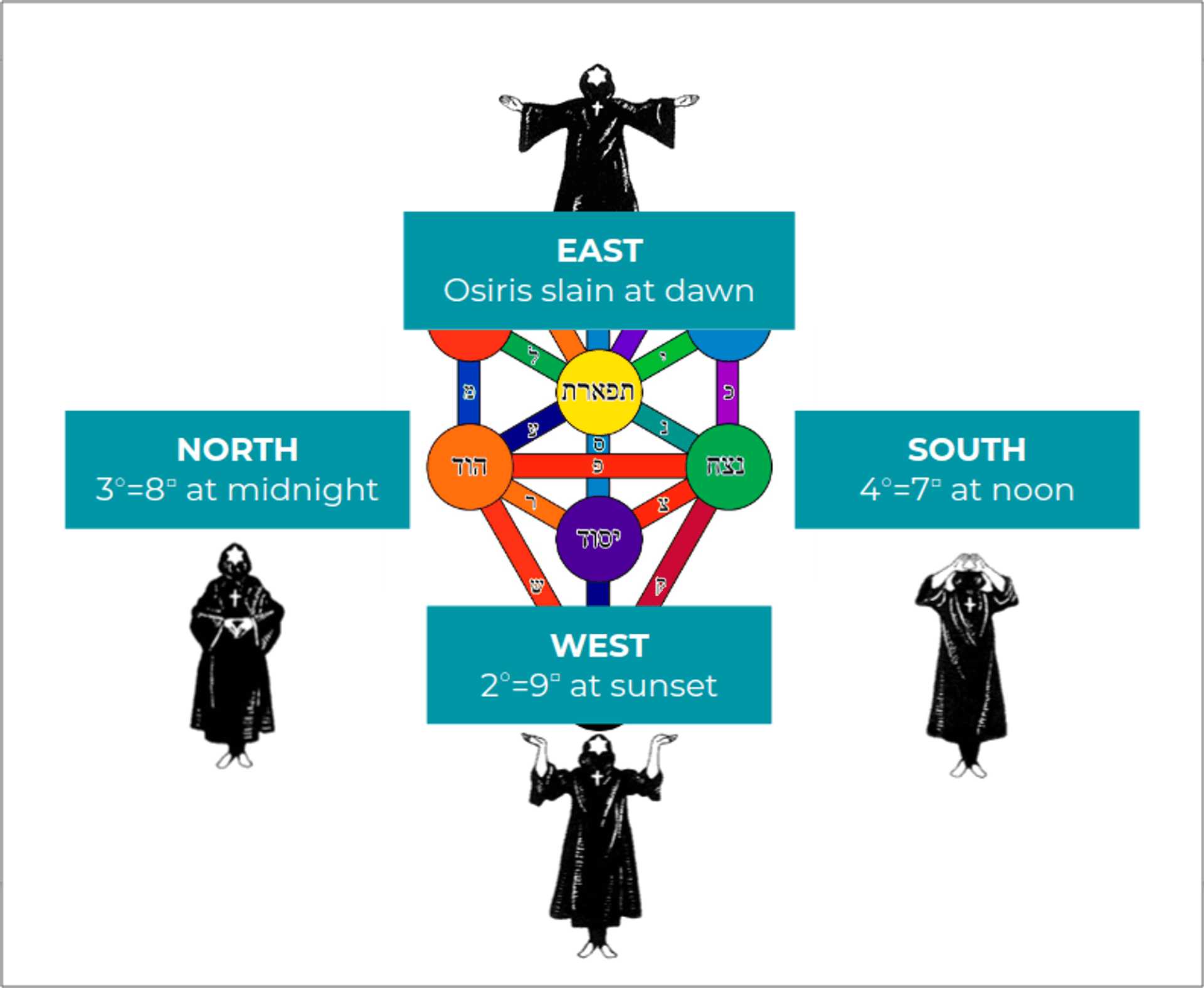
Noon #

"2. Also at Noon, let him greet the Sun, facing South, giving the sign of his grade. And let him say in a loud voice:
Hail unto Thee who art Ahathoor in Thy triumphing, even unto Thee who art Ahathoor in Thy beauty, who travellest over the Heavens in thy bark at the Mid-course of the Sun.
Tahuti standeth in His splendour at the prow, and Ra-Hoor abideth at the helm.
Hail unto Thee from the Abodes of Morning!"
Ahathoor was portrayed in many ways: a woman with cow horns, a woman with the head of a cow, or a whole cow.
Here another issue rises: if you live in the Southern Hemisphere, if you turn to South at Noon you will be turning your back to the Sun, the object of your adoration.
I know this is basic Geography and sounds silly, but let’s consider two hypothetical persons, our friend Grady McMurtry fighting in what appears to be the North of Africa, and our friend Marcelo Motta sailing a ship through the Ocean. Grady is in the Northern Hemisphere, and Marcelo is in the Southern Hemisphere.
When the Sun rises, both see it at East, they face the Sun and perform the adoration of Ra:
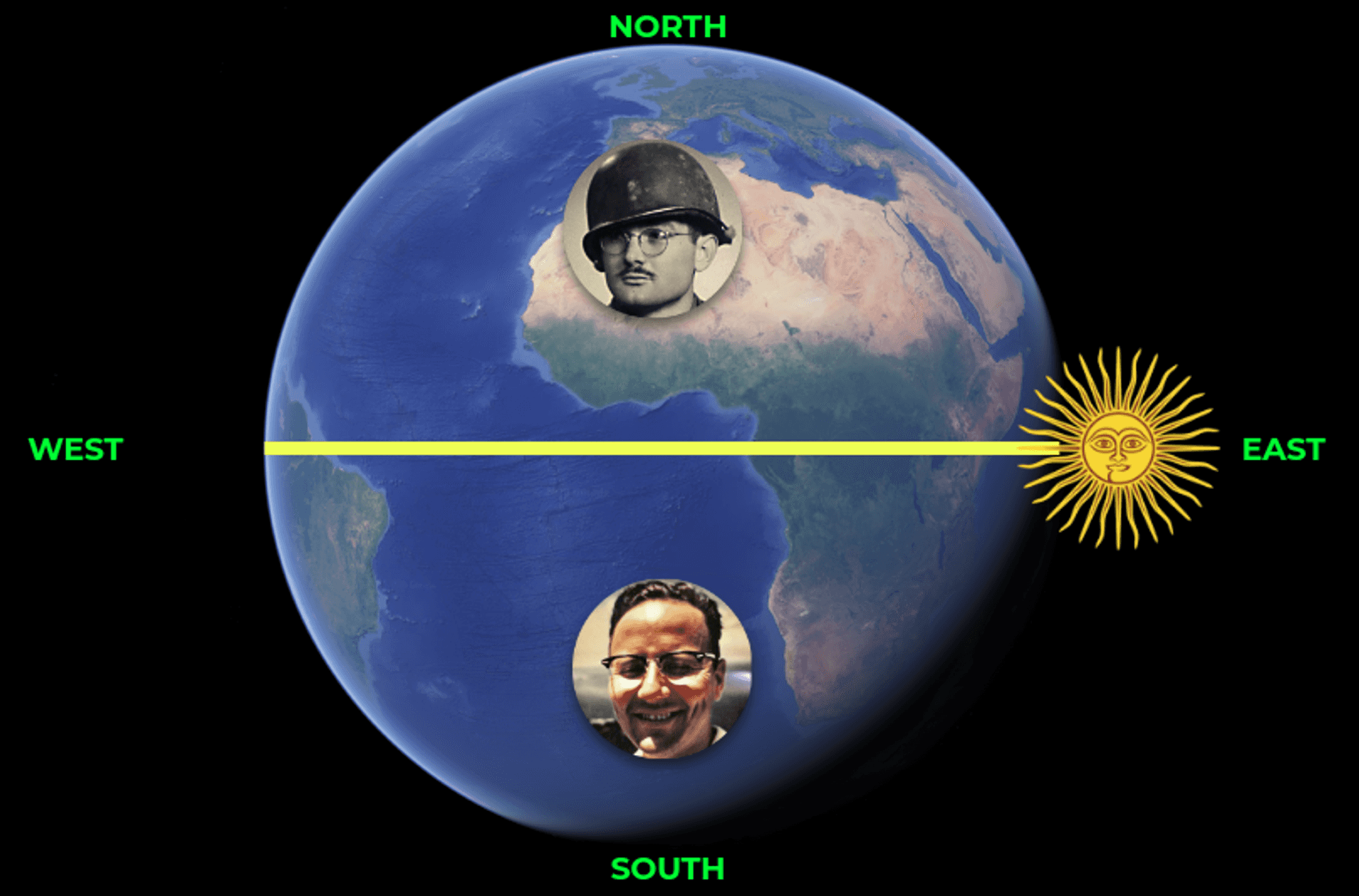
However, when the Sun is at Noon in their Meridian, Grady (from the Northern Hemisphere) will see the Sun at South, while Marcelo (from the Southern Hemisphere) will see the Sun at North.
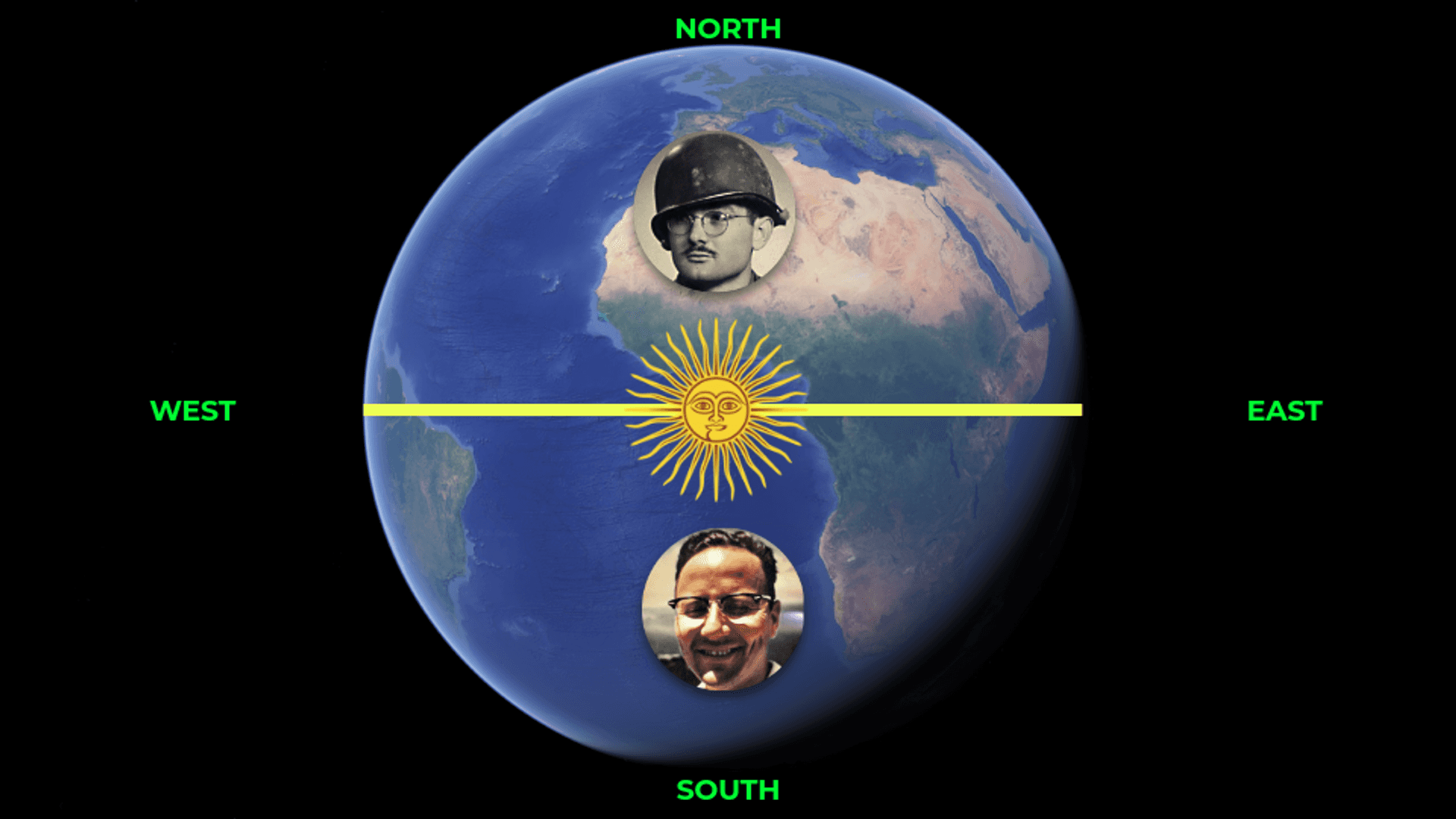
To complicate things a bit further, the Sun does not follow exactly the Equator line. Actually, it moves through the year between the Tropics of Cancer and Capricorn, so someone who lives in that area between the Tropics at certain times will see the Sun at North, at South, or exactly above them at Noon.
The golden rule is: get out of your house and take look at the damn Sun in the Sky.
But what about the signs? Should Marcelo give the Sign of 4○=7□ as taught by Crowley (who lived in the Northern Hemisphere) or the Sign of 3○=8□ since he is facing the opposite direction?
Well, we could simply visualize those two as if they were standing on the Tree of Life, each on one side, thus for both of them the Sun will be at Netzach, and both give the Sign of Philosophus 4○=7□ at Noon. Although this schema does not follow elemental attributions, it makes more sense to give the Sign of Fire (4○=7□) when the Sun is at its hottest time.
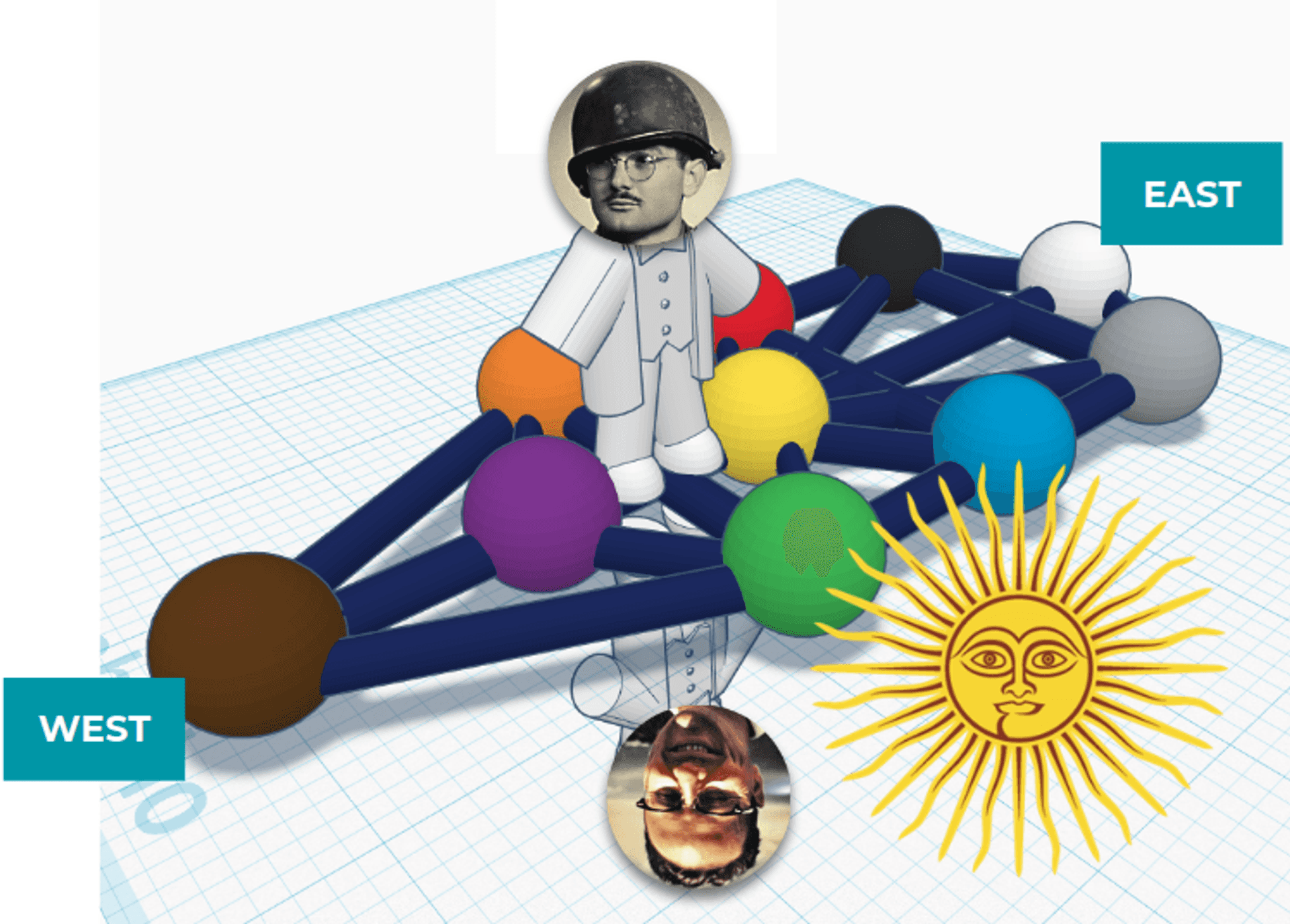
So here are the signs given by someone in the Southern Hemisphere who does not have a Grade in the A∴A∴ (please note the “flipped” Tree of Life in the background):
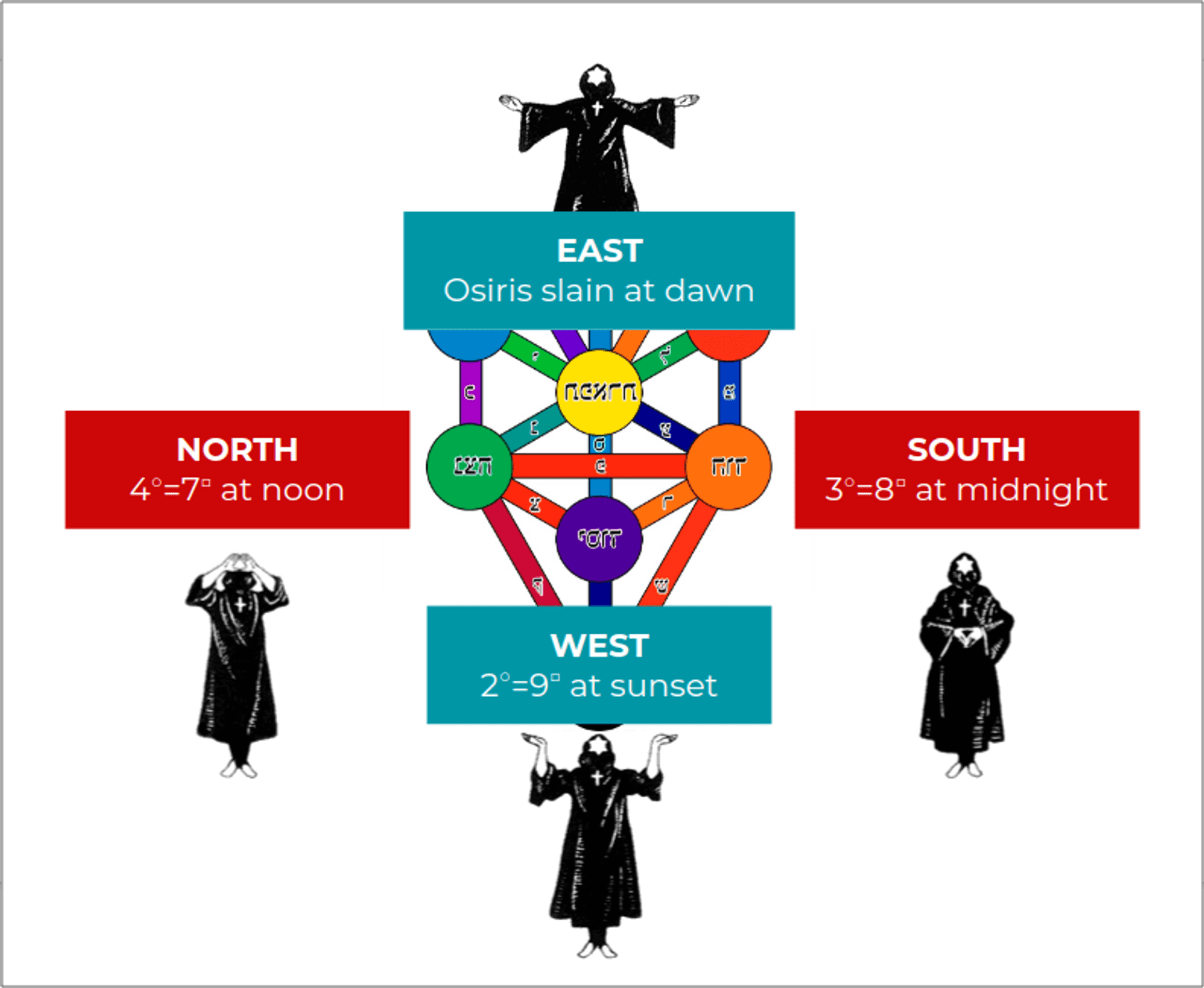
Sunset #
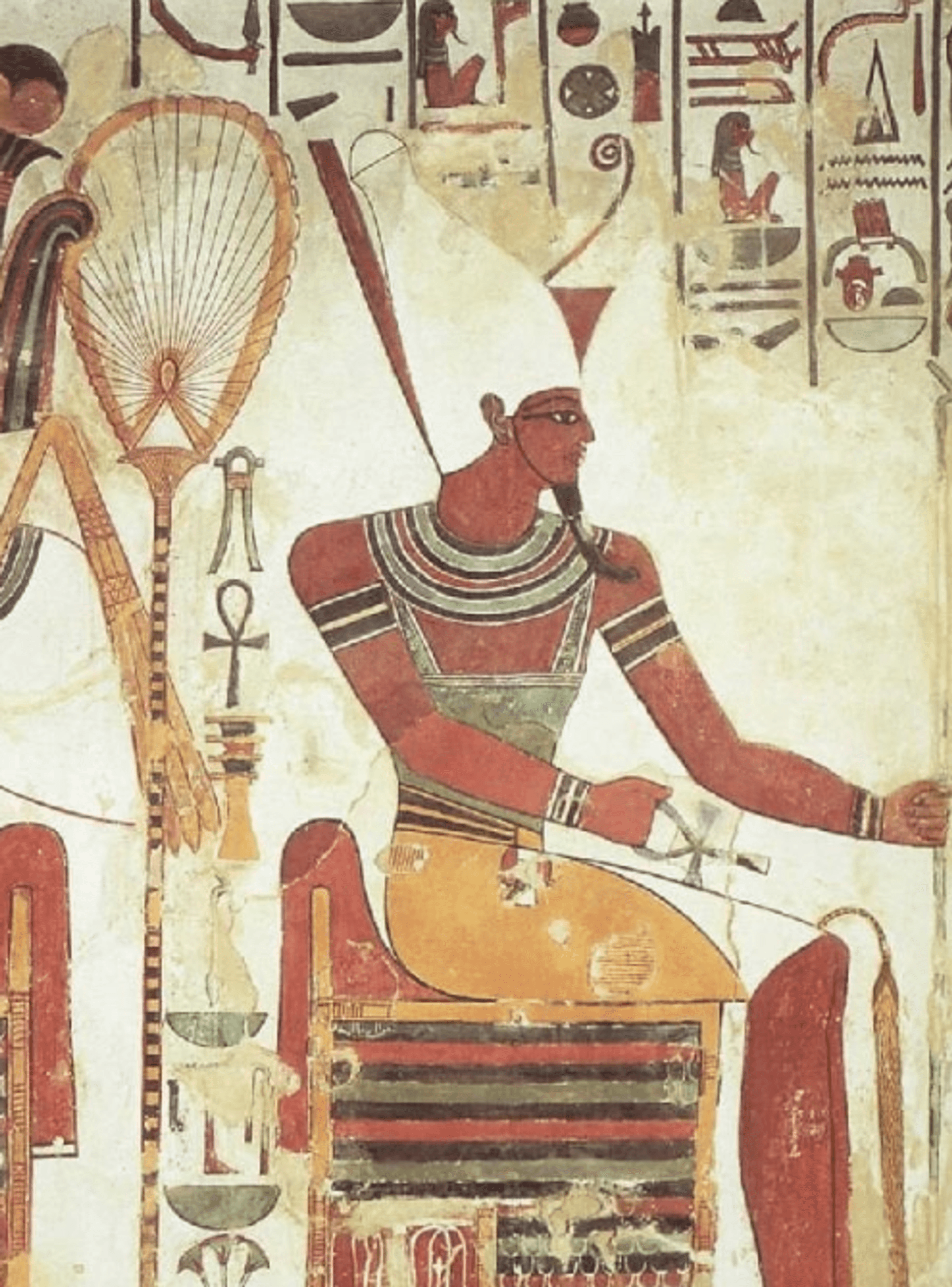
"3. Also, at Sunset, let him greet the Sun, facing West, giving the sign of his grade. And let him say in a loud voice:
Hail unto Thee who art Tum in Thy setting, even unto Thee who art Tum in Thy joy, who travellest over the Heavens in Thy bark at the Down-going of the Sun.
Tahuti standeth in His splendour at the prow, and Ra-Hoor abideth at the helm.
Hail unto Thee from the Abodes of Day!"
Midnight #
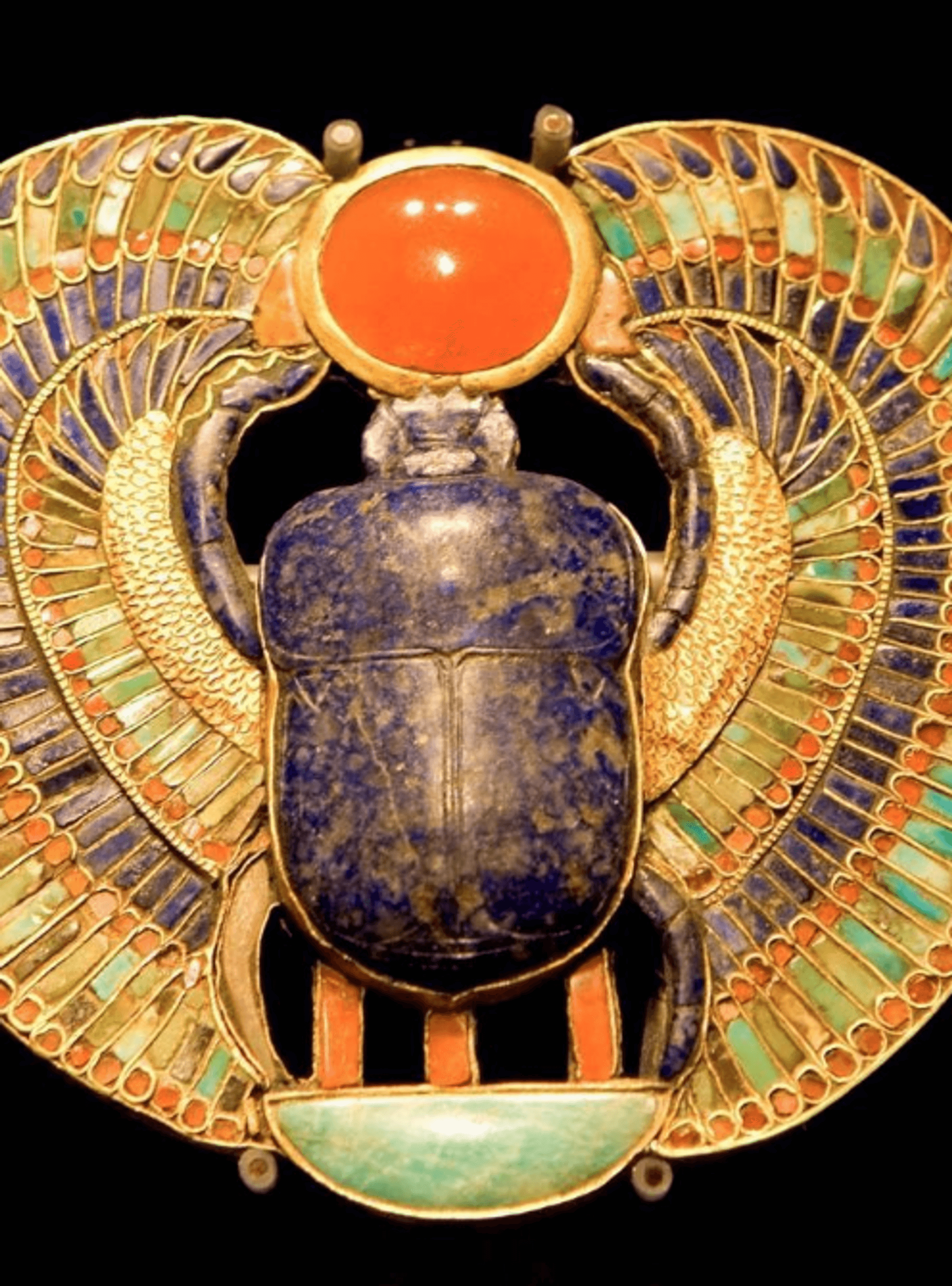
"4. Lastly, at Midnight, let him greet the Sun, facing North, giving the sign of his grade. And let him say in a loud voice:
Hail unto thee who art Khephra in Thy hiding, even unto Thee who art Khephra in Thy silence, who travellest over the Heavens in Thy bark at the Midnight Hour of the Sun.
Tahuti standeth in His splendour at the prow, and Ra-Hoor abideth at the helm.
Hail unto Thee from the Abodes of Evening."
Kephra also is depicted in different forms: sometimes he is a man with the head of a Scarab, and sometimes he’s a full Scarab with bird wings holding the Sun. Here I suggest using the second form.
Now it’s midnight for our friends, but how do they know to which direction they should face, if there’s no visible Sun on the sky?

Supposing the whole Universe stopped: the Earth is not spinning, the Solar System is not moving through the Galaxy, everything is motionless. Maybe Doctor Who has something to do with that! Well, our friends Grady and Marcelo are sick of being at midnight, so they want to move to a place where the Sun is at noon. For some reason, they want to move either straight up North or straight up South until they reach Noon:
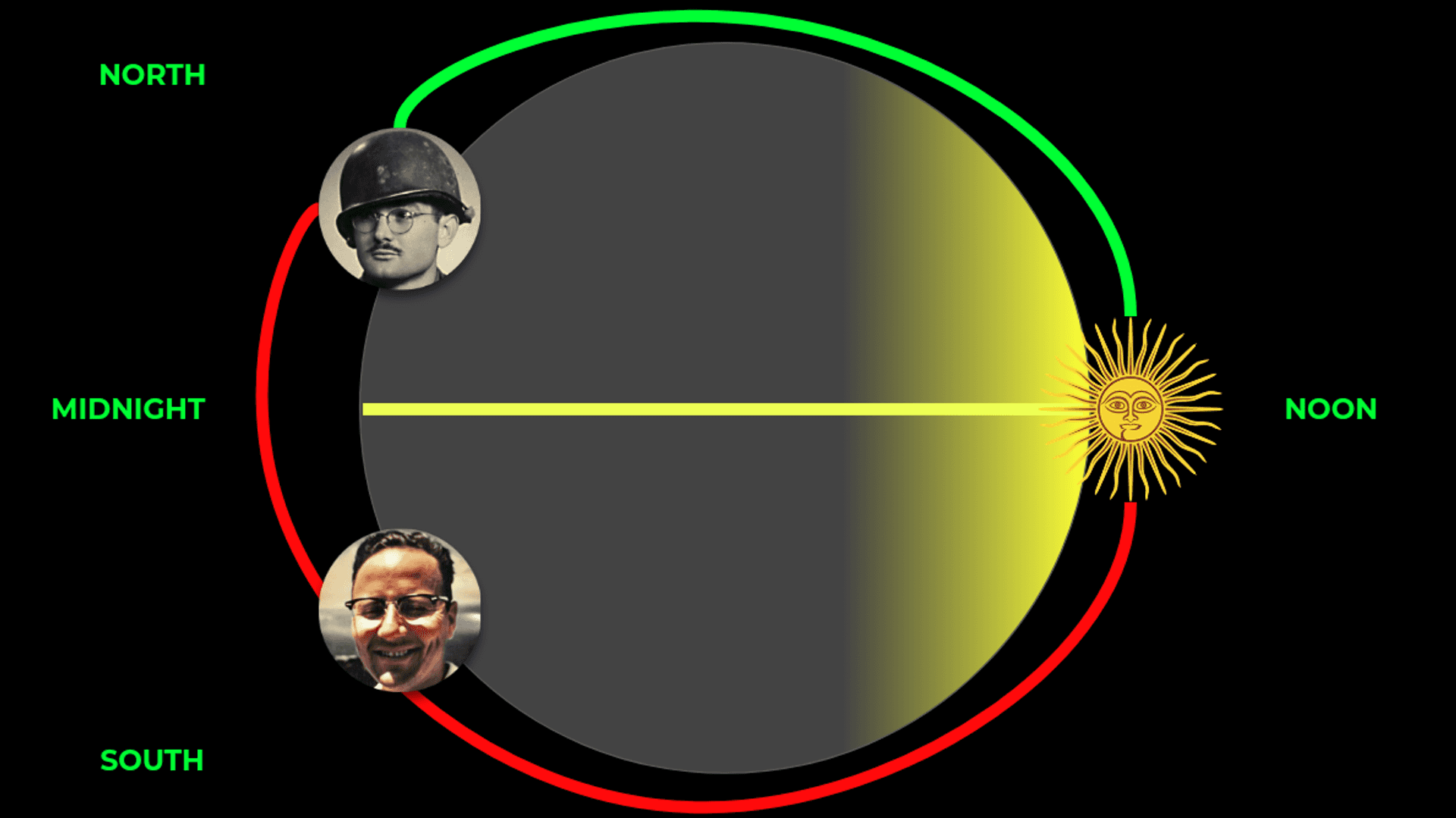
For Grady, the shortest path to the Sun is going North, while for Marcelo the shortest path is South. Thus, for people who live in the Southern Hemisphere, we also switch the Kephra adoration to the South.
The Second Adoration #

“5. And after each of these invocations thou shalt give the sign of silence, and afterwards thou shalt perform the adoration that is taught thee by thy Superior. And then do thou compose Thyself to holy meditation.”
Again: people who are not in the A∴A∴ won’t have a superior to teach them this additional adoration to be performed after Resh.
One traditional form taught by Thelemic orders is using Crowley’s rendering of the Stéle of Revealing as published in Liber AL vel Legis, Chapter III, vv. 37-38, where we also read “I adore thee in the song:—” and “So that thy light is in me; & its red flame is as a sword in my hand to push thy order. There is a secret door that I shall make to establish thy way in all the quarters, (these are the adorations, as thou hast written)”.

This is the first part taught. It skips the pretextual sentence and the first block of “I am the Lord of Thebes”. The whole is recited in the Sign of Osiris Risen:
“Unity uttermost showed!
I adore the might of Thy breath,
Supreme and terrible God,
Who makest the gods and death
To tremble before Thee—
I, I adore thee!
Appear on the throne of Ra!
Open the ways of the Khu!
Lighten the ways of the Ka!
The ways of the Khabs run through
To stir me or still me!
Aum! let it fill me!”
“Aum” can be fulled vibrated. After this first section, you can visualize the L.V.X. bathing your whole body of light, and then continue with the second section.
This is the second part. When you say “the light is mine” you refer to what you did after the first section.
“The light is mine; its rays consume
Me: I have made a secret door
Into the House of Ra and Tum,
Of Khephra and of Ahathoor.
I am thy Theban, O Mentu,
The prophet Ankh-af-na-khonsu!
By Bes-na-Maut my breast I beat;
By wise Ta-Nech I weave my spell.
Show thy star-splendour, O Nuit!
Bid me within thine House to dwell,
O wingèd snake of light, Hadit!
Abide with me, Ra-Hoor-Khuit!”


At the points where you mention Nuit, Hadit, and Ra-Hoor-Khuit, you can visualize them around you as if you were Ankh-f-n-Khonsu in the Stéle of Revealing. That is, Nuit is curved upon you, her feet at your front, her hands behind you; Hadit is the winged globe at the center of the Sky, under Nuit; Ra-Hoor-Khuit is sitting in his throne before you. When you finish the adoration, let his image sink in your mind.
End with the Sign of Silence.
Your point of view will be similar to the image found in The Aeon ATU, changing the position of Hadit to the top, Nuit rotated so that she bends above you, and Hoor-paar-kraat won’t be visible:
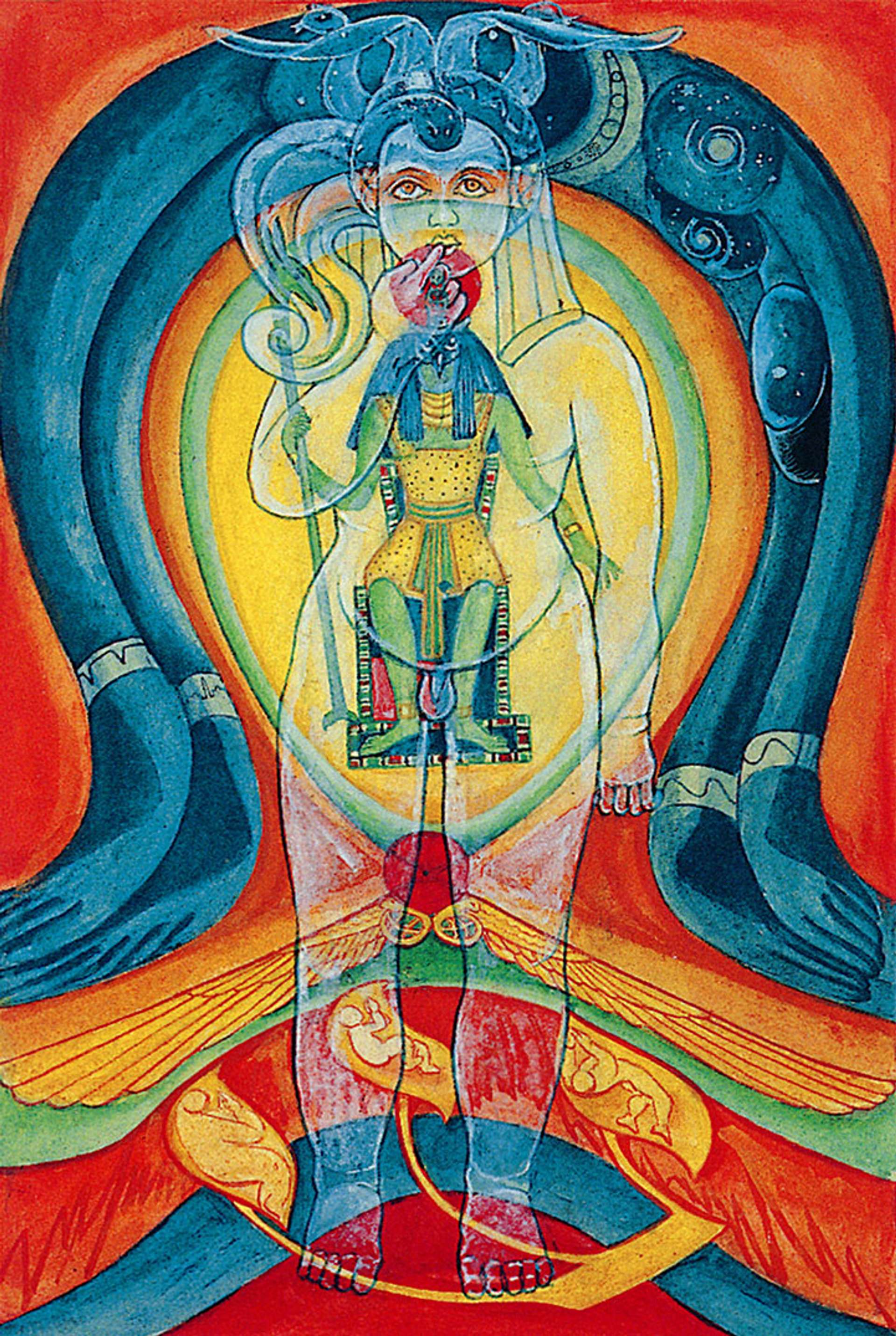
Final Remarks #
“6. Also it is better if in these adorations thou assume the God-form of Whom thou adorest, as if thou didst unite with Him in the adoration of That which is beyond Him.”
By “assume the God-form”, Crowley refers to a technique called Assumption of God-forms, taught in Liber O vel Manus et Sagittae:
"1. The Magical Images of the Gods of Egypt should be made thoroughly familiar. This can be done by studying them in any public museum, or in such books as may be accessible to the student. They should then be carefully painted by him, both from the model and from memory.
2. The student, seated in the ‘God’ position, or in the characteristic attitude of the God desired, should then imagine His image as coinciding with his own body, or as enveloping it. This must be practised until mastery of the image is attained, and an identity with it and with the God experienced.
It is a matter for very great regret that no simple and certain test of success in this practice exists."
Above we gave a sample of one image for each god. The basic posture of the gods (except for the above form of Kephra) is with the right hand holding an Ankh, the left hand holding an Ibis-headed staff, and the left foot slightly advanced.
So, at the moment of the first adoration, your physical body will give the Sign of your A∴A∴ Grade (or one of the Signs suggested by Crowley as explained above), while the magical image of the god will wrap your whole body in his or her proper posture. Once you finish the first adoration (the one found in Resh) and give the Sign of Silence, you should drop the God-form, and then proceed with the “adoration that is taught thee by thy Superior” or the alternative provided above.
Finally, Liber Resh ends with:
“7. Thus shalt thou ever be mindful of the Great Work which thou hast undertaken to perform, and thus shalt thou be strengthened to pursue it unto the attainment of the Stone of the Wise, the Summum Bonum, True Wisdom and Perfect Happiness.”
Proper Time #
Some Thelemic schools suggest beginners use the following fixed times for the adorations, every six hours:
| Dawn | Noon | Sunset | Midnight |
|---|---|---|---|
| 6:00 AM | 12:00 PM | 6:00 PM | 12:00 AM |
There are a few advantages in this schema: it’s fixed, you don’t need to calculate the correct times every couple of days, and that’s especially helpful if you travel a lot and sometimes miss a flight; it’s easier to form a habit, because you will follow the same pattern across the months; in the summer you will have six sweet hours of sleep (or so) between Midnight and Dawn.
However, the official instruction is clear:
“Let him greet the Sun at dawn […]
Also at Noon, let him greet the Sun […]
Also, at Sunset, let him greet the Sun […]
Lastly, at Midnight, let him greet the Sun”
The actual time of dawn, noon, sunset and midnight should be used. That time varies from place to place. For example, on July 30th, these were the times for Chapecó, Santa Catarina, Brazil and Fortaleza, Ceará, Brazil:
| Dawn | Noon | Sunset | Midnight | |
|---|---|---|---|---|
| Chapecó | 7:12 | 12:36 | 18:02 | 00:36 |
| Fortaleza | 5:42 | 11:40 | 17:39 | 23:40 |
Both cities are at the exact same timezone (GMT - 3 hours), however, Fortaleza is far Eastern than Chapecó, and the Sun “reaches” that city first.
Even in the same city, the times of the Sun change along the year, so if you follow the real time pattern, you should adjust your alarm clock every day or two:
| Dawn | Noon | Sunset | Midnight | |
|---|---|---|---|---|
| Mar 20th | 6:34 | 12:37 | 18:40 | 00:37 |
| Jun 20th | 7:19 | 12:32 | 17:45 | 00:32 |
| Sep 20th | 6:21 | 12:23 | 18:25 | 00:23 |
| Dec 20th | 5:30 | 12:28 | 19:23 | 00:28 |
This is a chart showing how the sunrise and sunset change across a full year in Chapecó, Brazil:

At the Equinoxes the Day and Night will have the same duration, at the Summer Solstice we have the longest day, and at the Winter Solstice, we have the longest night.
A couple of years ago I watched a movie called “30 Days of Night”, where vampires terrorize a little town which is so far to the North that at a certain time of the year they have a 30-days long night. Well, that little city little exists, it’s called Utqiaġvik, in Alaska, and actually they do not have a 30 days-long night. In winter, they have a 66-days long night and in the summer they have a 80-days longe day!
How do I perform Resh in Utqiaġvik at those occasions of the year? Ra on May 11th, Ahathoor in mid-June, and Tum on August 1st? We must allow some flexibility since the purpose is to regularize the practices.
I suggest that at least for one year the practitioner perform Resh at the exact time of Dawn, Noon, Sunset, and Midnight, but that after one had that experience of the days moving, the winter coming, the sun getting stronger again, one could be more flexible and move to a new pattern, and follow it until one attains to the Great Work:
| Dawn | Noon | Sunset | Midnight |
|---|---|---|---|
| When you wake up | When you have lunch | When you perceive the evening | Right before going to sleep |
In many cases the time will be close enough to the actual times of the Sun (unless you have a nocturne life and sleeps at 5 AM and wakes up at 2 PM, in that case, I suggest you adapt properly); and now you have a new challenge: you cannot use clocks anymore. Let your own inner clock remind you of your obligations and the Great Work you swore to attain.
What if I miss an adoration? #
It’s better late than never. If you miss it at 6:30 AM, it’s okay to perform it 7:45 AM and then write in your diary the reason for being late. If you are often late, you may detect a pattern in your failures, and do something about it.
If you are so late that now it is time for the next adoration, you could either mark it in your diary as a failure, or (as suggests Frater Aureus) consider that at some point on Earth the Sun is always rising, always at noon, always setting, and always at midnight — visualize yourself there and perform it.
What if I can’t perform an adoration? #
Every day at Ahathoor time you are at the office. What can you do? Well, the instruction is clear, you have to give certain signs, recite certain things in a loud voice, and so on. However, what’s worse? Skipt it or adapt it? Can’t you just go to the bathroom and perform a full Resh? Can’t you at least close your eyes for a minute and perform it in your mind? It is not ideal, but it’s better than nothing.
Marcelo Ramos Motta reports:
“You will attract not only attention to yourself, but the deadly enmity of Christists —— to say nothing of other crapulous creeds —— if you do something like this. I used to do it, when I was in college in the U.S.A., at a time when I was under special surveillance by order of Mr. J. Edgar Hoover, and remember being approached by an agent who made no special effort to remain inconspicuous and asked why I stopped in the middle of the street and babbled words to myself. […] You should say the Adorations fully whenever you can, but in public you may merely say them interiorly, putting either your forefinger or your thumb to your lips, depending on your Grade or your pleasure. The important detail is not to forget them —— ever! Also, you must realize that the Stations of the Sun have absolutely nothing to do with normal clock time. They have to do with Local Time, and most specially the meridian that happens to be over your head. It is Noon when the Sun is crossing the local meridian, no matter what the clock says. And if you are on a mountaintop the Sun will set much later, and rise much earlier, than if you are in a valley. Skyscrapers also count. And south of the Equator, noon and midnight are reversed cardinal points. Either you keep these things in mind or you will end up with dead dogma such as “Christmas” and Holy Inquisitions in your hands. If you feel that it is better to have them in your hands than at your throat, you are becoming crapulous, friend. Or rather ex — friend.”
Putting it All Together #
1. Face the Sun:
| Dawn | Noon | Sunset | Midnight | |
|---|---|---|---|---|
| Northern Hemisphere | East | South | West | North |
| Southern Hemisphere | East | North | West | South |
2. Hold the Sign of your A∴A∴ Grade or the Sign associated with the quarter:
| Dawn | Noon | Sunset | Midnight |
|---|---|---|---|
| Adeptus Minor | Philosophus | Zelator | Practicus |
| 5○=6□ | 4○=7□ | 2○=9□ | 3○=8□ |
| Tiphareth | Netzach | Yesod | Hod |
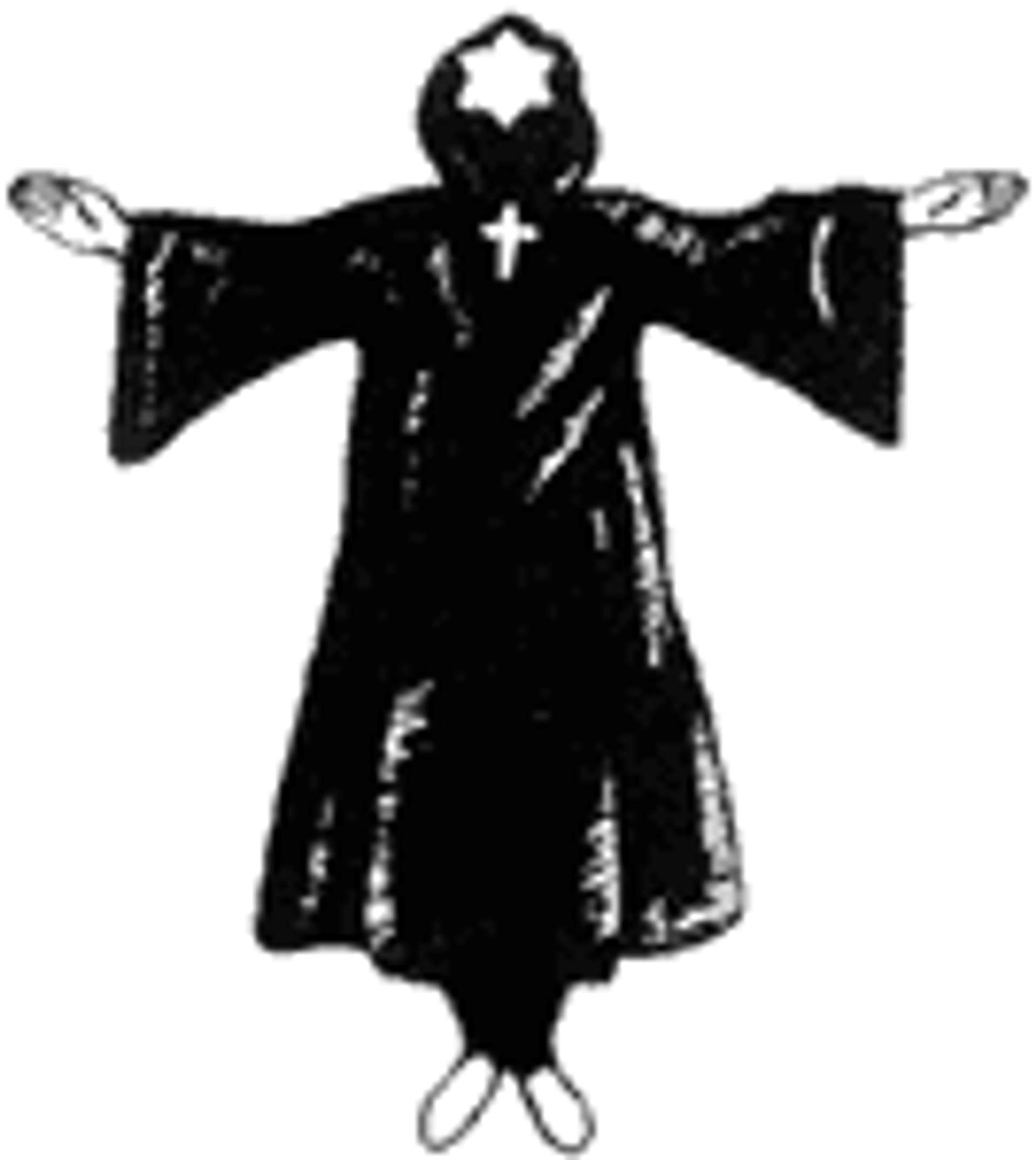 |  |  | 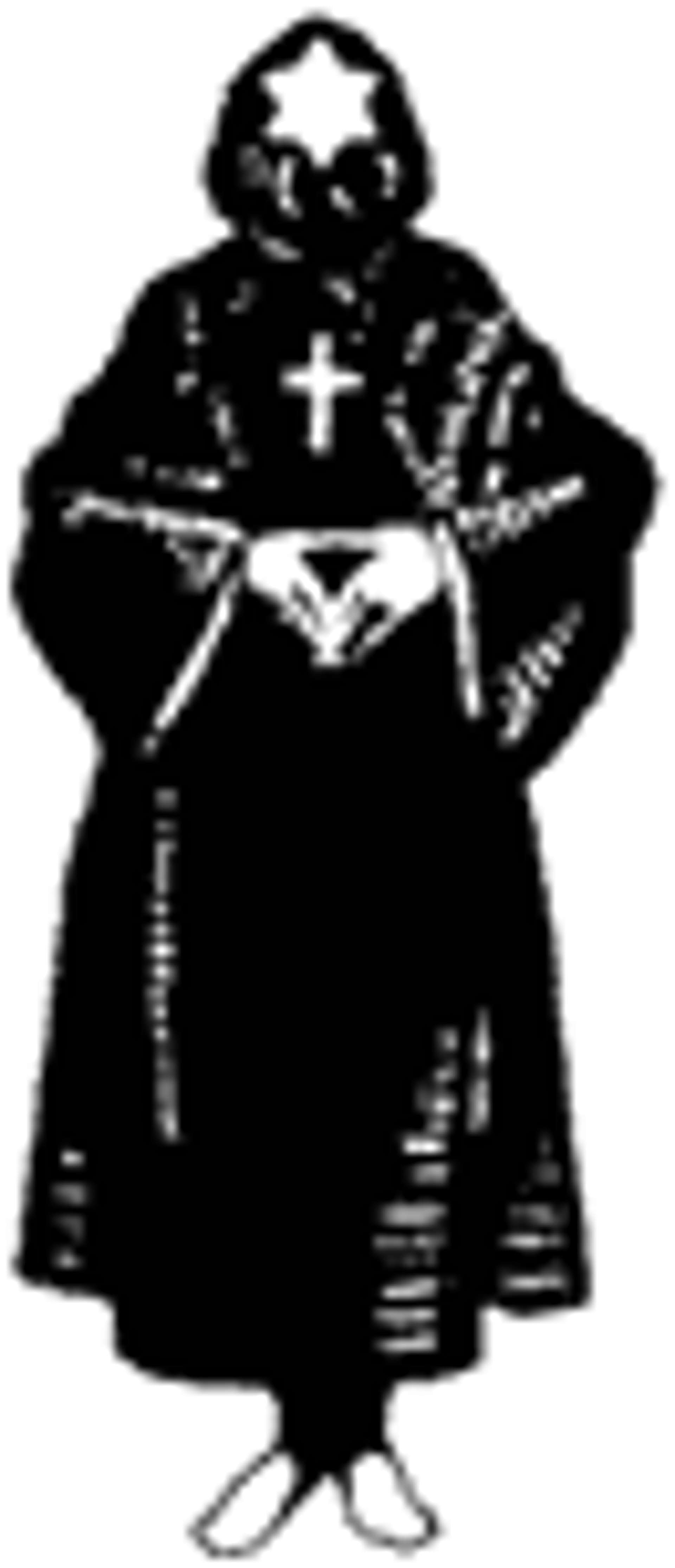 |
3. Assume the form of the God or Goddess associated with the Sun position:
| Dawn | Noon | Sunset | Midnight |
|---|---|---|---|
 |  |  |  |
| Ra | Ahathoor | Tum | Kephra |
| Rising | Triumphing | Setting | Hiding |
| Strength | Beauty | Joy | Silence |
| Uprising | Mid-course | Down-going | Midnight Hour |
| Night | Morning | Day | Evening |
4. Perform the adoration as found in Liber Resh.
5. Give the Sign of Silence, and drop the God-form:

6. Perform the adoration that your A∴A∴ instructor taught you. If you do not have an A∴A∴ superior to teach you the second adoration, you can proceed as follows:
7. Hold the Sign of Osiris Risen:

8. Perform the adoration taken from Liber Legis, III:37-38:
“Unity uttermost showed!
I adore the might of Thy breath,
Supreme and terrible God,
Who makest the gods and death
To tremble before Thee—
I, I adore thee!
Appear on the throne of Ra!
Open the ways of the Khu!
Lighten the ways of the Ka!
The ways of the Khabs run through
To stir me or still me!
Aum! let it fill me!
The light is mine; its rays consume
Me: I have made a secret door
Into the House of Ra and Tum,
Of Khephra and of Ahathoor.
I am thy Theban, O Mentu,
The prophet Ankh-af-na-khonsu!
By Bes-na-Maut my breast I beat;
By wise Ta-Nech I weave my spell.
Show thy star-splendour, O Nuit!
Bid me within thine House to dwell,
O wingèd snake of light, Hadit!
Abide with me, Ra-Hoor-Khuit!”
9. Give the Sign of Silence to end:

References #
- Postcards to Probationers; The Equinox, Vol. I N. 2, by Aleister Crowley
- Liber O vel Manus et Sagittae; The Equinox, Vol. I N. 6, by Aleister Crowley
- Stepping Out of the Old Æon Into the New; The Equinox, Vol. III N. 1, by Charles Stansfeld Jones.
- Living Thelema, by David Shoemaker
- Magick Without Tears, by Aleister Crowley
- The Confessions of Aleister Crowley, by Aleister Crowley
- Liber AL vel Legis: The Book of the Law, by Aleister Crowley
- Liber Aleph: The Book of Wisdom or Folly, by Aleister Crowley
Thanks for reading
Since you've made it this far, sharing this article on your favorite social media network would be highly appreciated 💖! For feedback, please write to alanwillms at gmail dot com.